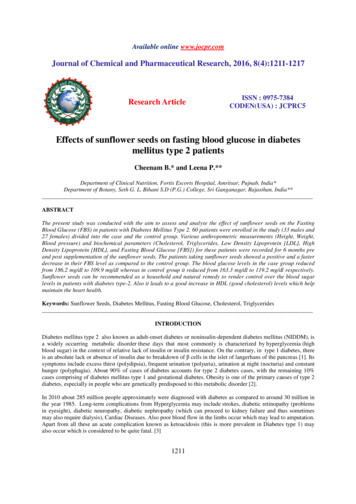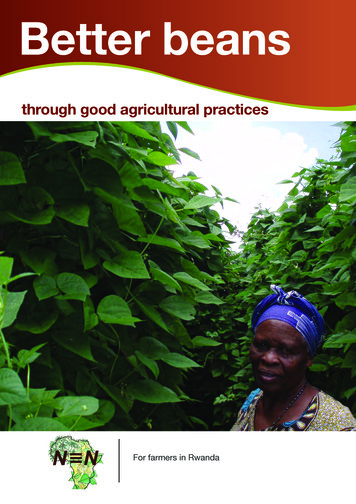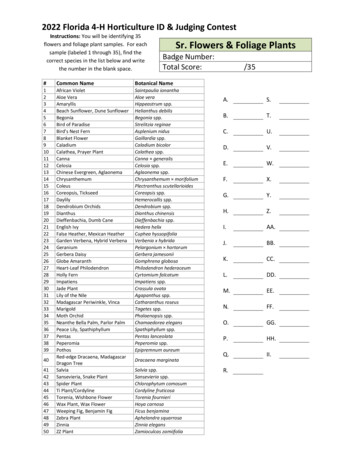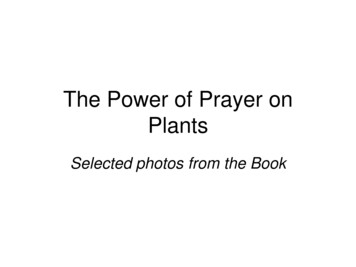
Transcription
Available online www.jocpr.comJournal of Chemical and Pharmaceutical Research, 2016, 8(4):1211-1217Research ArticleISSN : 0975-7384CODEN(USA) : JCPRC5Effects of sunflower seeds on fasting blood glucose in diabetesmellitus type 2 patientsCheenam B.* and Leena P.**Department of Clinical Nutrition, Fortis Escorts Hospital, Amritsar, Pujnab, India*Department of Botany, Seth G. L. Bihani S.D (P.G.) College, Sri Ganganagar, Rajasthan, India**ABSTRACTThe present study was conducted with the aim to assess and analyse the effect of sunflower seeds on the FastingBlood Glucose (FBS) in patients with Diabetes Mellitus Type 2. 60 patients were enrolled in the study (33 males and27 females) divided into the case and the control group. Various anthropometric measurements (Height, Weight,Blood pressure) and biochemical parameters (Cholesterol, Triglycerides, Low Density Lipoprotein [LDL], HighDensity Lipoprotein [HDL], and Fasting Blood Glucose [FBS]) for these patients were recorded for 6 months preand post supplementation of the sunflower seeds. The patients taking sunflower seeds showed a positive and a fasterdecrease in their FBS level as compared to the control group. The blood glucose levels in the case group reducedfrom 186.2 mg/dl to 109.9 mg/dl whereas in control group it reduced from 163.3 mg/dl to 119.2 mg/dl respectively.Sunflower seeds can be recommended as a household and natural remedy to render control over the blood sugarlevels in patients with diabetes type-2. Also it leads to a good increase in HDL (good cholesterol) levels which helpmaintain the heart health.Keywords: Sunflower Seeds, Diabetes Mellitus, Fasting Blood Glucose, Cholesterol, TriglyceridesINTRODUCTIONDiabetes mellitus type 2 also known as adult-onset diabetes or noninsulin-dependent diabetes mellitus (NIDDM), isa widely occurring metabolic disorder these days that most commonly is characterized by hyperglycemia (highblood sugar) in the context of relative lack of insulin or insulin resistance. On the contrary, in type 1 diabetes, thereis an absolute lack or absence of insulin due to breakdown of β cells in the islet of langerhans of the pancreas [1]. Itssymptoms include excess thirst (polydipsia), frequent urination (polyuria), urination at night (nocturia) and constanthunger (polyphagia). About 90% of cases of diabetes accounts for type 2 diabetes cases, with the remaining 10%cases comprising of diabetes mellitus type 1 and gestational diabetes. Obesity is one of the primary causes of type 2diabetes, especially in people who are genetically predisposed to this metabolic disorder [2].In 2010 about 285 million people approximately were diagnosed with diabetes as compared to around 30 million inthe year 1985. Long-term complications from Hyperglycemia may include strokes, diabetic retinopathy (problemsin eyesight), diabetic neuropathy, diabetic nephropathy (which can proceed to kidney failure and thus sometimesmay also require dialysis), Cardiac Diseases. Also poor blood flow in the limbs occur which may lead to amputation.Apart from all these an acute complication known as ketoacidosis (this is more prevalent in Diabetes type 1) mayalso occur which is considered to be quite fatal. [3]1211
Cheenam B. and Leena P.J. Chem. Pharm. Res., 2016, 8(4):1211-1217Crunchy, Nutty and sweet, sunflower seeds prove to be an incredible source of calories, minerals, vitamins andessential fatty acids. The seeds are most commonly utilized in the extraction of edible oil at a commercial scalethroughout the world. The seeds of sunflower can be consumed as a delicious snack. [4]Sunflower plant is an erect, herbaceous, tall annual plant belonging to the family of Asteraceae of the genus,Helianthus. The botanical name of the sunflower seeds is Helianthus annuus. The seeds first originated in theMiddle American region. It is from this place that it escalated as an important commercial crop all over the world.[4]Delicious and crunchy sunflower seeds are widely appraised as great health food. They are high in calories and alsoan impressive source of health benefiting nutrients, vitamins, minerals, and antioxidants. A good amount of theircalories come from the fatty acids. The seeds are specifically rich in PUFA i.e. poly-unsaturated fatty acid mainlylinoleic acid, which contribute around 50% fatty acids in them. Oleic acid, a mono-unsaturated fatty acid (MUFA) isalso found in good amounts in the seeds. Research studies suggest daily diet schedule with good amounts of MUFAprevent cardiac disorders and stroke by maintaining a healthy lipid profile. [5]Sunflower seeds like other nuts are also a rich source of proteins with high quality of amino acids such as tryptophanpresent in it. Tryptophan is essential for growth, especially in children. In addition to this, these seeds contain healthpromoting poly-phenol compounds such as quinic acid, caffeic acid and chlorogenic acid. These contain certainnatural anti-oxidants in it that help discard harmful oxidant molecules (in simpler terms toxins) from the body [5][6].Sunflower kernels are one of the richest sources of B-complex vitamins. Very precisely these are very good sourcesof niacin, folic acid, thiamin (vitamin B1), pyridoxine (vitamin B6), pantothenic acid, and riboflavin. [6]The seedsare also incredibly rich sources of many essential minerals. Iron, Zinc, Manganese, Copper, Selenium and Calciumare especially concentrated in sunflower. Many of these minerals play a vital role in hormone production, enzymesynthesis, red blood cell production, bone mineralization, as well as regulation of metabolic, cardiac and skeletalmuscle activities [7]In this study, the effects of sunflower seeds were studied on the blood glucose levels of patients with diabetes type 2.The blood glucose evaluation includes – Fasting Blood Glucose (FBS)EXPERIMENTAL SECTIONThe sample of about 60 people (33 males and 23 females) was selected from the state of Punjab, with age rangingfrom 45-55yrs (sample patients selected under the knowledge of the administration). The sample was divided intotwo groups- control and case group (30 people in each group); where the control group was only given the requireddiet counseling whereas the case group was fed on 2 gm sunflower seeds per day along with the required dietcounseling [8].The pre- supplementation data in both the cases was collected with the help of a dietary survey, anthropometricmeasurements, biochemical testing which comprised of their diet history, diabetes history, height chart, BMI, FBS[8][11].The sunflower seeds slightly roasted for about 2 minutes were fed to the control group for a period of 6 months. Thepre and post supplementation data was recorded and the various biochemical parameters were checked at eachmonth’s end. The data collected was put to statistical analysis using SPSS software and unpaired t-test to find outthe result. [8]1212
Cheenam B. and Leena P.J. Chem. Pharm. Res., 2016, 8(4):1211-1217Comparison of Readings186.2163.0148.7143.5119.2109.9FBS 1FBS 3FBS 6FBS 1CaseFBS 3FBS 6ControlG.Fig. 1: The comparison between the control and case group showing the mean of the values of FBS per visitComparison ofReadings(G)95.797.496.6Visit 1Visit 3Visit 6113.4114.4115.4Visit 1Visit 3Visit 6CaseControlLDL.Fig. 2: The comparison between case and control group showing the mean of the values of LDL per visit1213
Cheenam B. and Leena P.J. Chem. Pharm. Res., 2016, 8(4):1211-1217Comparison of Readings43.139.237.138.1HDL 1HDL 340.034.9HDL 1HDL 3HDL 6CaseHDL 6ControlG.Fig. 3: The comparison between case and control group showing the mean of the values of HDL per visitComparison ofReadings(G)129.3128.9127.1125.6121.2Visit 1Visit 3120.3Visit 6Visit 1CaseVisit 3Visit 6ControlTgl.Fig. 4: The comparison between Case and control group showing the mean of the values of Triglycerides (Tgl) per visit1214
Cheenam B. and Leena P.J. Chem. Pharm. Res., 2016, 8(4):1211-1217Comparison ofReadings(G)167.9164.3163.8Visit 3Visit 6154.9Visit 1146.6146.0Visit 3Visit 6Visit 1CaseControlCholFig. 5: The comparison between case and control group showing the mean values of Cholesterol (Chol) per visitClosely observing the graphs it gives a view how the case group (the ones being fed with sunflower seeds) shows abetter decrease in the levels of FBS (Control group 163 mg/dl to 119.2mg/dl; Case group 186.2 mg/dl to 109.9mg/dl) as shown in Fig: 1. Along with the FBS the values of Cholesterol (Control group 167 mg/dl to 163.8 mg/dl;Case group 154.9 mg/dl to 146 mg/dl) showed in Fig: 5 and triglycerides (Control group 129.3 mg/dl to 125.6mg/dl; Case group 128.9 mg/dl to 120.3 mg/dl) also show a positive and better decrease than the control group asshown in Fig: 4. Apart from FBS, Cholesterol (Chol) and Triglycerides (Tgl) HDL (the good cholesterol) also showa good increase in the case group than the control group (Control group 37.1 mg/dl to 40 mg/dl; Case group 34.9mg/dl to 43.1 mg/dl) can be seen in Fig: 3.RESULTSApplying the simple paired t-test using SPSS Software the following results were achieved.Table 1, 2: The case and control group with the relative ePostPrePostPrePostPrePost154.90 146.03 128.93 120.3395.7096.6334.943.1186.2109.9Mean25.769 16.395 31.488 17.173 16.348 16.325 6.133 9.070 29.3625.495S.D.3.7332.8060.4992.61211.195Paired T test0.001*0.009*0.622**0.014*0.000*P value2.052.052.052.052.05Table Value at 0.05 df 29ResultSignificantSignificantNot PostPrePostPrePostPrePostPrePostPrePost167.93 163.83 129.33 125.60 113.37 115.3737.140163119.20Mean20.139 13.277 13.8179.77514.993 11.034 4.041 1.086 30.3936.578S.D.2.1943.1231.7116.93112.830Paired T test0.036*0.004*0.098**0.000*0.000*P value2.052.052.052.052.05Table Value at 0.05 df 29ResultSignificantSignificantNot SignificantSignificantSignificantNOTE: S.D Standard Deviation, *- Significant, **- Non Significant, n 60 (30 case, 30 control)Chol: Cholesterol, Tgl: Triglycerides, LDL: Low Density Lipoprotein, HDL: High Density Lipoprotein1215
Cheenam B. and Leena P.J. Chem. Pharm. Res., 2016, 8(4):1211-1217In table 1 (Case group) for cholesterol the p-value comes out to be 0.001 ( 0.05), for triglycerides it comes out tobe 0.009 ( 0.05), for HDL 0.014 ( 0.05), for FBS 0.00 ( 0.05) making these values significant, whereas in case ofLDL the p-value comes out to be 0.622 ( 0.05) hence making it insignificant.In table 2 (Control group) for cholesterol the p-value comes out to be 0.036 ( 0.05), for triglycerides it comes out tobe 0.004 ( 0.05), for HDL 0.00 ( 0.05), for FBS 0.00 ( 0.05) making these values significant, whereas in case ofLDL the p-value comes out to be 0.098 ( 0.05) hence making it insignificant.DISCUSSIONAs per the results the sunflower seeds have proved to show a positive and a better effect in reducing the FBS levelsin patients with Diabetes type-2 along with a good increase in HDL (good cholesterol). Just half a spoon ofsunflower seeds every day provides the recommended level of proteins, vitamins, minerals and phenolic antioxidants. Further, as already discussed sunflower seeds are rich in chlorogenic acid. The chlorogenic acid helps incontrolling the blood sugar levels by reducing or limiting the glycogen breakdown which takes place in the liver.Hence, leads to a good control of the blood sugar levels in the patients with Diabetes type -2 [6]Amongst other studies, Flax seeds were used to find out their effectiveness to control the blood sugar levels. Briningto use a randomized crossover design, nine glucose intolerant obese people were told to consume 40 g groundflaxseed every day for around 12 weeks (84 days) with a 4-week washout period. The study’s results weaklysupported the decrease in insulin resistance due to the antioxidant activity of flaxseed. [9]The effect of fenugreek was studied on the RBS (Random Blood Sugar) or the postprandial glucoseand insulin levels following the MTT (Meal Tolerance Test) in non-insulin dependent diabetics (NIDDM). Thepowdered fenugreek seed around (15gm) was soaked in water and given. It was significantly found to reduce therespective postprandial glucose levels. The fenugreek was also found to lower the plasma insulin level in NIDDMbut without a statistical difference. Fenugreek did not show a very good effect on lipid levels 3 hrs post theMTT. Fenugreek proved to propagate a potential benefit in the treatment of NIDDM. [10]In the above studies, flax seeds do not show a good effect whereas fenugreek seeds do show a good effect but onlyon the blood glucose levels but does not show good effect in consideration to the heart health. Also, fenugreek seedsused in the study is about 15gm per day which is much higher that the quantity of sunflower seeds shown in thepresent study (2gm).Sunflower seeds have about 3 grams of fiber and 5 grams of protein in an ounce of kernels apart from the otherbenefits [7]. Thus, a small amount of sunflower seeds taken on a regular basis say being added on top of salads, inthe vegetable mixtures, in oats or other cereals or can be taken as it is as a health snack (in moderation). This wouldhelp the masses in better control of their blood sugar levels and maintain their heart health too by maintaining thelevel of HDL in the blood.CONCLUSIONThe crunchy, nutty and delicious sunflower seeds are highly considered to be a great health food. They are energydense seeds; 100 g seeds provide about 584 calories. Along with this, they are phenomenal source of healthbenefiting antioxidants, minerals, vitamins and nutrients. Sunflower Seeds with a mild nutty taste and a wide rangeof the above mentioned nutrients can serve as a filling as well as a nutritious food. With respect to the gatheredresults in the study, sunflower seeds can be recommended as a great household and a natural remedy to rendercontrol over the blood sugar levels in patients with diabetes type-2. Also it leads to a good increase in HDL (goodcholesterol) levels which help maintain the heart health in people.REFERENCES[1] K Kumar, S Vinay, N Fausto, AK Abbas, C Cotran, S Ramzi. Robbins and Cotran Pathologic Basis of Disease,7th edition, Pa.: Saunders Publishers, Philadelphia, 2005, 87-101.[2] S Smyth; A Heron, Nature Medicine., 2006, 12 (1), 75-80[3] OA Fasanmade; IA Odeniyi; AO Ogbera, African J. of medicine and medical sciences., 2008; 37 (2), 99-105.1216
Cheenam B. and Leena P.J. Chem. Pharm. Res., 2016, 8(4):1211-1217[4] AH Ensminger, ME Ensminger, JE Kondale, JRK Robson. Foods & Nutrition Encyclopedia, 2nd edition, PegusPress Publishers, California, 1983, 285-91.[5] KM Phillips; DM Ruggio; KM Ashraf, The J. of Agriculture and Food Chemistry., 2005; 30, 9436-45.[6] MV Krimer, PS Madarev, Z Vastag, V Preedy, V Patel, W Ronald, Nuts and Seeds in Health and DiseasePrevention, 1st edition, Elsevier Publications, 2011, 28-36.[7] C Wood, S Rebecca. The Whole Foods Encyclopaedia, 1st edition, NY: Prentice-Hall Press, New York, 1988,113-9[8] N Kssaian; L Azadbakht; B Forghani; M Amini, International J. on Vitamin and Nutrition Research., 2009; 79,34-39.[9] R Yeong; B Ardith, Nutrition Journal., 2011, 10, 1475-79.[10] Z Madar; R Abel; S Samish; J Arad, European J. of Clinical Nutrition., 1988, 42(1), 51- 54[11] DJ Jenkins; CW Kendall; EG McKeown; RG Josse; J Silverberg, The J. of American Medical Association.,2008, 300, 2742–53.1217
About 90% of cases of diabetes accounts for type 2 diabetes cases, with the remaining 10% cases comprising of diabetes mellitus type 1 and gestational diabetes. Obesity is one of the primary causes of type 2 . The data collected was put to statistical analysis using SPSS software and unpaired t-test to find out the result. [8]










